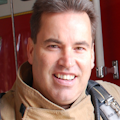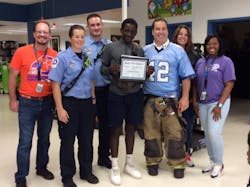Fire Prevention: Would You Take Advice from You?
It starts off as a simple question: “Are you more likely to take advice from a stranger or from a trusted friend?” “From a government agency or from a community-based organization?”
Community risk reduction (CRR) involves changing the attitudes and behaviors of individuals to influence their risk profile. We do this through the Three E’s of prevention: education, engineering and enforcement. However, although we can engineer and enforce a magnitude of safety devices and policies, if we don’t educate, we won’t make any real progress. Only education truly will change the attitudes that will be reflected in behaviors that will take advantage and make use of the aforementioned, thus reducing risk.
Take sprinkler systems, for example. Here is a finely tuned engineering tool that has been in place since the 1800s; through codes, its use even has been enforced. Yet fire still kills more Americans every year than all natural disasters combined.
Another example: seatbelts—an engineering tool that has been in existence since the 1950s and has been steadily enforced (49 states have some sort of law). Nevertheless, almost half of those who were killed in motor-vehicle accidents every year weren’t wearing a seatbelt.
The message from these two examples: Just because safety devices are engineered and are available, and just because their use is enforced, doesn’t mean that they will be maintained, used or used correctly. Education is the key to CRR, and it even can be argued that engineering (the innovation of safety devices) and enforcement (the passing of laws) have roots in education.
So, a true CRR program must include educational approaches that will instill attitude-changing behaviors that will reduce risk. How many of us have tried to convince an older adult, who for decades has performed life skills without aid, that it might be time for a ramp, slip-resistant flooring or grab bars in the bathroom. In her book, “The Unthinkable,” Amanda Ripley states that a person’s brain will place personal experiences over warnings. Given this, to be successful at CRR, you need to address these challenges, to increase the odds that those who are within the risk population of your community not only will listen to your advice but will do so to such a degree that their attitudes will be changed and their behaviors will be altered.
Embracing community rapport
Merriam-Webster defines rapport as a close and harmonious relationship by which the people or groups concerned understand each other’s feelings or ideas and communicate well. Key words: understand and communicate. So, although a CRR program should involve traditional presentations, displays and media messages, it also must involve the continuous underlying goal of developing rapport with the community that you serve, in particular, with those who comprise your “at risk” populations.
Through rapport, you begin to understand the culture of the community, the particular problems and challenges that they face, and how those elements form the views and beliefs of their world and the dangers that are in it. With that understanding, you can shape your communication and messages in a manner and format that increases the chances that they will be received, understood and accepted. For example, a family that struggles to put food on the table or to pay the electric bill might not deem the purchase of safety items, such as smoke alarms, lifejackets and bicycle helmets, a reasonable priority. Only by understanding their plight, understanding and speaking their “language” and being a trusted friend from a community resource are you more likely to bridge that gap.
To build rapport you can’t be an abstract entity who wears a uniform and badge. A person who they see from time to time, most often after an emergency, who recites scripted safety messages and regurgitates statistics. You can’t speak to them in a language and format that doesn’t resonate with them. It’s not about you; it’s about them, their family, their lives, their well-being, and if you don’t approach CRR with this attitude, then CRR isn’t for you. You have to be willing to become both a researcher and a social chameleon and to take the time to learn, understand and appreciate the community that you’re serving, to understand their issues and to form your messages to encompass those issues.Developing community rapport
To learn and appreciate this background, and to begin to develop this rapport, you need to seek out, attend or even plan community events that don’t center on safety or CRR. Be present and visible, not for the purpose of lecturing or presenting but to support their event—or add to it by bringing an apparatus. Seek out and attend community cookouts, block parties, school award programs, parent nights at school and social group meetings, such as the Rotary Club. Seek opportunities to have conversations with people in a nongovernmental/official way, but as a concerned, involved, excited fellow community member. Learn their families, their views, their beliefs, their core values, and their concerns and fears. By doing so, become a member of that community who is committed to its well-being right alongside of them.
As fire service professionals who respond to tragedy, study statistics and see firsthand how accidents happen, we know what needs to be done to reduce those numbers and occurrences. Knowing and telling people who are in the community simply isn’t enough. We can no longer sit upon the governmental hill and lecture down to the masses. We must come down into the community, become a part of that community, to truly understand all of the dynamics that are involved. This includes the values and beliefs that lead to tragedy. We must learn the language that’s needed to develop attitude- and behavior-changing rapport.
The fire service badge is one of the most respected and trusted in the community. Those who wear it are in the pole position to influence changes in their community. Imagine what can be accomplished when you establish rapport and when the members of the community actually meet the person behind the badge.
About the Author

Daniel Byrne
DANIEL BYRNE is a community support officer for the Burton Fire District, Beaufort County, SC, and a retired assistant fire chief of training for the Georgia Air National Guard 165th Fire Department. A third-generation firefighter, he holds an associate degree and a bachelor’s degree in fire science as well as a master’s degree in public administration and disaster management. Byrne is an alumnus of the National Fire Academy. He received state and local awards for public relations and educational programs as well as community partnerships and served as a conference presenter and keynote speaker.

